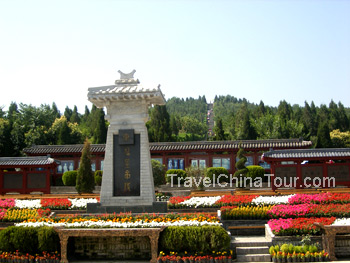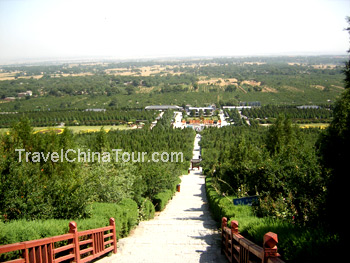Ancient Chinese believed in the immortality of the soul and because of this belief, the dead were buried such that their after life would enjoy the same luxuries as the living. From the 1600's BC to 300's BC, when nobles died, their slaves were buried with them. In 384 BC., this practice was abolished, and after-wards, the nobles buried clay figures and statues in place of slaves.
Even early on during his lifetime, Emperor Qin Shihuang was aware of his mortality. He sent thousands of his subjects on searches for the secret of immortality, and often made trips himself to holy mountains to seek immortality. Emperor Qin Shihuang employed over 700,000 men to construct his tomb even at a young age, and had 8,000 sculpted solider created to accompany him to the after life.

The mausoleum of Emperor Qin Shihuang lies 5km east of the county of Lintong. It borders mount Li in the south and the Wei River in the north. The mausoleum covers an area of 57 square kilometers where over 500 accessory burial pits, subordinate tombs have been discovered.
Qin Shihuang's arrogance is well documented, and he had believed himself to be equal to the gods, and never gave up on seeking the secret of immortality. Despite this, he is widely regarded as the single most influential emperor in Chinese history as the first emperor. During his lifetime, he unified the warring states, created new code of laws, standardized the system of weights and measures, reformed the currency system, and established a single form of written language. He also connected the unified states by building roads, and extended the walls of the conquered states to form the earliest construction of the Great Wall of China.
The Mausoleum of emperor Qin Shihuang is the largest in China. It was originally named Lishan. Qin Shihuang began construction of his tomb in 247 BC when he ascended the throne. Construction of the tomb took another 2 years under his son's rule before it was complete - bringing the total years of construction to 39 years.

Look down on top of the hill.
The mausoleum was built such that it would serve the dead as if were still alive, and the most valuable things during the emperor's lifetime was buried along with him - so that he may enjoy them in the afterlife. The mausoleum was modeled after the imperial capital. Under the large hill in the center is a grand palace built underneath. The hill rises 75 meters tall with a base running 350 meters long. The palace underneath, although never excavated, is believed to be 20 meters deep under ground. The height and thickness of its city walls are 4 meters. The inner city walls has a circumference of 3870 meters, and the outer city walls has a circumference of 6240 meters. There are 4 gates on each of the four sides of the inner and outer city walls.
The mausoleum also contains all kinds of buildings, tombs, subordinate burial pits, which indicate that the emperor's tomb contained everything available in the real capital city. Over 100 subordinate pits and several hundred tombs have been discovered. Some of these have been excavated and include: to the west and north are bronze horse-drawn carriage vault, along with a pit for rare birds and animals. To the west of the mausoleum is the L shaped stable pit. There are also the subordinate tombs for princes and princesses, the stone armour pit, the pit of terra-cotta warriors and horses. With all these excavation, there still remains so much that still remain uncovered.
Read about my tour of the Qin Shihuang Mausoleum here.
|